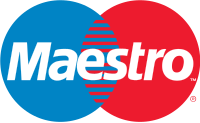Maestro (debit card)
 The Maestro logo | |
| Product type | Debit card |
|---|---|
| Owner | Mastercard |
| Country | United States |
| Introduced | 1992 |
| Related brands | Debit Mastercard |
| Markets | Worldwide |
| Website | www |
Maestro (stylized as maestro) is a multi-national debit card service owned by Mastercard that was founded in 1992. Maestro cards are obtained from associate banks and can be linked to the card holder's current account, or they can be prepaid cards. The cardholder presents the card at the point of sale (POS) and this is swiped through the payment terminal by the assistant or the customer, inserted into a chip and PIN device or read by a contactless reader. The payment is authorized by the card issuer to ensure that the cardholder has sufficient funds in their account to make the purchase and the cardholder confirms the payment by either signing the sales receipt or entering their 4 to 6-digit PIN, except with contactless transactions below a specified amount for which no further verification is required.
Maestro often requires on-line electronic authorization for every transaction, although Mastercard's rules permit the establishment of floor limits on Maestro EMV chip transactions only. Not only must the information stored in either the chip or the magnetic stripe be read, this has to be sent from the merchant to the issuing bank, the issuing bank then has to respond with an affirmative authorization. If the information is not read, the issuer will decline the transaction, regardless of any disposable amount on the connected account, except in the Asia Pacific region, where manual keyed entry is permitted under some circumstances. This is different from most other debit and credit cards, where the information can be entered manually into the terminal (i.e. by punching the 13 to 19 digits and the expiry date on the terminal) and still be approved by the issuer or stand-in processor. In most countries, other than those specified in Mastercard's rules, a PIN rather than a signature is always required to authorise a Maestro transaction, except where no CVM is required.
Maestro is accepted at around fifteen million point of sale outlets.[1]
Acceptance and availability
- In Germany and Austria, Maestro replaced the Eurocheque system. Austrian Maestro cards are virtually always pure Maestro cards. German Maestro cards, however, are in most cases co-branded with the German Girocard logo. These co-branded cards work like normal Maestro cards within the Maestro network and as Girocards within the Girocard network, but they cannot be used as Maestro over the telephone or on the internet.
- In Belgium, Maestro cards are co-branded with the Belgian Bancontact logo (previously Bancontact/Mister Cash).
- In the United Kingdom, the former Switch debit card system was re-branded as Maestro. Underneath the branding, however, the system was still the old Switch one and the cards were still fundamentally Switch. In 2011, MasterCard aligned UK Domestic Maestro (the former Switch) with the standard international Maestro proposition, ending its status as a separate card scheme. This change also led to the discontinuation of the Solo (debit card). [2] In January 2009 First Direct and HSBC discontinued the use of Maestro card, issuing Visa Debit cards to new customers and a gradual roll-out throughout 2009 to existing customers. In September of the same year, the British arms of the National Australia Bank, being the Clydesdale Bank and the Yorkshire Bank, started the process of replacing the Maestro card with a Debit MasterCard for their current accounts, except for the Readycash and Student accounts, for which the Maestro card continued to be issued until 2015. Likewise, in the same month the Royal Bank of Scotland Group (Europe's largest debit card issuer which includes the NatWest, Coutts and Ulster Bank brands) switched from Maestro to Visa Debit, a process that took two years to complete.[2][3][4] This effectively meant that only a few smaller UK banks would be issuing Maestro cards. In 2015, Bank of Ireland UK replaced its Maestro debit cards with Visa Debit cards.
- In Ireland, Laser, which was co-branded with Maestro, has been replaced by Visa Debit and Debit MasterCard. The Laser debit card has been phased out by all banks and ceased to operate from March 2014. Irish Laser cards carried Maestro co-branding from 2008 onwards. They were intended to be used with chip and PIN POS systems. The chip on the card was programmed with two applications, one for Laser and one for Maestro. POS transactions were normally processed over the Laser network in Ireland and the Maestro network when the card was used abroad. Some POS terminals prompted users to manually select Laser or Maestro before completing the transaction. Laser cards could be processed as Maestro in most POS terminals worldwide for chip and PIN or swipe and sign transactions (where still accepted). Internet and telephone-based retailers, however, needed to be set up specifically to accept Irish Laser/Maestro cards. Transactions made with these cards were often secured by MasterCard's SecureCode system to verify the cardholder's identity. These cards were usually multi-functional and operated as a debit card as well as an ATM Card which could be used for accessing ATMs. Some banks also allowed customers to use their cards to deposit or withdraw money over the counter or at An Post post offices using their debit card and PIN. Historically the cards often contained a Cheque guarantee card function indicated by a hologram. This scheme was shut down in 2011. Foreign-issued Maestro cards are still accepted in Ireland in ATMs and by many POS machines. However, acceptance of Visa and MasterCard debit/credit cards is more reliably universal at POS terminals.
- In Denmark, Maestro has been replaced by the banks that issued it with Debit MasterCard. Moreover, the largest Danish bank Danske Bank has replaced all of its cash cards with Debit MasterCards.
- In the United States, Maestro is a PIN-based debit card network closely related to the Cirrus ATM network, also owned by MasterCard. Like other PIN-debit networks in the U.S., Maestro there relies solely on a standard card and PIN, without a chip; signature-debit transactions in the U.S. are handled through the main MasterCard network or the rival Visa network. RBS's U.S. subsidiary, Citizens Financial Group, also began a switch to Visa, though like most foreign banks with operations in the United States it uses MasterCard's Cirrus network and the card participates in the MasterCard SecureCode initiative.
- In Brazil, MasterCard acquired the existing Redeshop service in 2002 and rebranded it as Maestro.
- In parts of Latin America, Maestro was known as MasterCard Maestro, and used a different logo.
- In Argentina, Maestro is the card used by the Banco de la Nacion Argentina and other banks, mostly state-run or provincial banks.
- In Venezuela, Maestro is extremely popular. It is as of 2014, the leading debit card, issued by almost all major banks in the country. It is widely accepted in POS. It works on all ATMs showing the Suiche7B, MasterCard, Conexus and Cirrus logos.
- In India, Maestro is issued by most major banks, except ICICI Bank. Maestro issuing banks include the State Bank of India (India's largest bank), State Bank's affiliate banks, Punjab National Bank, Syndicate Bank, Oriental Bank of Commerce, Bank of Rajasthan, etc.
- In Israel, Maestro Cards cannot be used at point of sales locations to make purchases but the Cirrus network is accepted at a majority of cash points most of the time. The exception is the 'First International Bank of Israel' (FIBI) who do not accept Cirrus.
- In China, Bank of China uses Maestro as its "international" debit card system. Also, certain Bank of China ATMs will present the user with Japanese or Korean language options upon insertion of a Maestro card.
- In Romania, Maestro was a popular debit card (the third one after Visa Electron and Debit MasterCard), is still issued by 3 banks: BCR, BRD and Credit Agricole.
- In Russia, Maestro is issued by banks including Sberbank, which issues cards such as MasterCard Maestro Momentum and the Social MasterCard Maestro Debit Card.
- In Italy, banks issue both Maestro and V PAY cards (the latter works only in Europe); both are usually co-branded with the national Bancomat/PagoBancomat scheme.
- In the Netherlands, almost all banks issue Maestro debit cards, with only one bank offering V PAY instead of Maestro cards. Prior to 2012, Dutch Maestro debit cards were co-branded with the national PIN scheme. This scheme has since been retired and replaced by Maestro and V-PAY.
- In Serbia, Maestro debit cards are issued by several banks in Serbia. The main issuer was Banca Intesa Beograd until, in September 2012, Banca Intesa Beograd began to switch to Visa.[5]
- In Japan, Maestro debit cards with EMV chips issued outside the Asia Pacific region, the Netherlands and Canada are temporarily unable to be used at ATMs in Japan due to an upgrade to the regional ATM network. In addition, Seven Bank announced in April 2013 that all MasterCard cards, including Maestro, would no longer be accepted at their ATMs due to a disagreement with MasterCard.[6][7][8]
- In Greece, Maestro debit cards have been issued by several major banks.[9] However, as of March 2015 all four major Greek banks have replaced Maestro cards with contactless Debit MasterCard.
- In Chile, Maestro debit cards are widely used, dual-branded with RedCompra, issued by the majority of banks (Santander issues only Maestro debit cards). They operate through the local Transbank and Cirrus network. Usually, Chilean Maestro cards have a small logo on the back of the card. Debit MasterCard cards aren't issued in Chile. Chilean Maestro cards usually are contactless.
See also
References
- ^ [1] Maestro Netherlands
- ^ Your card - RBS - The Royal Bank of Scotland The Royal Bank of Scotland
- ^ Natwest Your card National Westminster Bank
- ^ Visa Debit Ulster Bank
- ^ "VISA Inspire". Banca Intesa. Retrieved 2014-06-24.
- ^ "ATM notification". MasterCard. Retrieved 2014-06-24.
- ^ セブン銀行. "お知らせ | セブン銀行". Sevenbank.co.jp. Retrieved 2014-06-24.
- ^ "Seven Bank to Discontinue ATM Services for Overseas-Issued MasterCard Brand Cards" (PDF) (Press release). Seven Bank. 2013-04-17. Retrieved 2014-06-24.
- ^ "Where to apply". MasterCard. Retrieved 2014-06-24.


